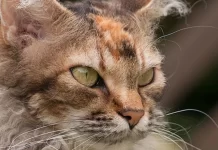Last Updated on November 22, 2023 by Fumipets
Are Fiddle Leaf Figs Toxic to Cats? What You Need To Know!
The question of whether fiddle leaf figs are toxic to cats is an important consideration for pet owners. This summary explores the potential risks and provides answers to common questions regarding the interaction between fiddle leaf fig plants and feline companions.
Although fiddle leaf figs make stunning indoor plants, cats and dogs cannot handle them. The plant’s insoluble calcium oxalate crystals, which resemble tiny needles, may have harmful side effects for your cat, including mouth irritation, frequent drooling, and difficulties eating.
It’s preferable to store fiddle leaf figs outside of your house since they are so harmful to cats. You should at the very least put the plant in a difficult-to-reach area for your cat.
Continue reading to find out more about fiddle leaf figs’ toxicity to cats. This page describes why fiddle leaf figs are poisonous to cats, how to prevent your cat from coming into contact with the plant, and other indoor plants that are secure around cats.
Are Fiddle Figs Toxic to Cats?
Sadly, fiddle leaf figs are poisonous to cats. Fiddle leaf figs may irritate the mouth and cause extreme burning in the tongue, lips, excessive drooling, vomiting, and even trouble swallowing when consumed. When consumed by dogs and other animals, fiddle leaf figs have the same negative consequences.
Which Part of a Fiddle Leaf Fig Is Toxic to Cats?
Insoluble calcium oxalate is the poisonous component of fiddle leaf figs. When swallowed, these tiny needle-like crystals attach themselves in a human or animal’s mouth, throat, and stomach. Fiddle leaf figs are poisonous to cats, dogs, and even people because of this. The plant’s stems and leaves, as well as all of its other parts, often include these crystals.
Other indoor plants also contain this hazardous substance besides fiddle leaf figs. In reality, insoluble oxalates are present on the leaves, stems, and even sap of many home plants. Other plants that are poisonous for the same cause are listed below:
Arrowhead
Calla lily
Peace lily
Chinese evergreen
Dieffenbachia
Elephant’s ear
These are some of the most typical indoor plants, while there are others that contain the same hazardous substance. By searching online for your particular plant, you may quickly determine if your indoor plant has insoluble calcium oxalate crystals.

How Do I Keep My Cat Away From My Fiddle Leaf Fig?
There are methods to keep the plant away from your cat, or your cat away from the plant, if you already have a fiddle leaf inside and don’t want to get rid of it.
Location Is Everything
Most essential, position the plant away from other raised surfaces like tables and chairs and in a corner. The cat could attempt to play with the leaves or perhaps eat them while sitting on the surface if the plant is too near to an elevated surface.
For the fiddle leaf fig, a vacant nook away from other furniture in your house can be the ideal spot. The fig will not only fill the empty spot with color and vitality, but the cat won’t have easy access to the plant either.
Cat Proof the Pot
The cat may still climb up on the pot and perhaps play with the plant, even if you set the fiddle leaf fig at the optimal spot. Just cat proof the pot to stop it from occurring. Chicken wire or garden matting are options for cats. The material should simply be spread over the pot’s surface.
The cat can’t play in the soil or climb into the pot thanks to this substance. The material also has enough ventilation to ensure that the soil receives the air and water it needs to support a healthy plant.
What If My Cat Eats a Fiddle Leaf Fig?
If you are aware that your cat has eaten a fiddle leaf fig, you should call your veterinarian right away. Call the ASPCA at (888) 426-4435 if you don’t have a veterinarian on hand.
A cat that has eaten a fiddle leaf fig will be treated by having its mouth cleaned out with distilled water. This distilled water will lessen further oral irritability and stop the cat from ingesting more pollutants.
Additionally, an emetic will be given to the cat. Any plant matter that hasn’t been digested by your cat will be expelled from its system by an emetic. To further stop your cat from ingesting the plant’s poisons, your veterinarian can also recommend giving it activated charcoal. The veterinarian could also wish to provide Kapectolin or Sucralfate in a critical case.

Which House Plants Are Safe For Cats?
Simply choosing indoor plants that are safe for cats is the greatest approach to keep your cat safe. There are other substances that may be poisonous as well, despite the fact that many indoor plants are dangerous for cats due to the insoluble calcium oxalate.
Here is a list of plants that may live in a house with cats, dogs, and other animals without causing any harm.
African violet
Baby tears
Bird’s nest fern
Boston fern
Bromeliad
Calathea orbifolia
Date palm
Friendship plant
Gloxinia
Parlor palm
Polka dot plant
Ponytail palm
Rattlesnake plant
Spider plant
Staghorn fern
Venus flytrap
Watercolor peperomia
Your cat and dog are safe to consume any of these plants. Additionally, they may add beauty and originality to any house.
Conclusion
Despite their beauty, fiddle leaf figs are poisonous to cats, dogs, and other animals due to the insoluble calcium oxalate crystals that they contain. If ingested, these crystals may lodge in the cat’s mouth, throat, and stomach.
It’s better to avoid having this plant in your home at all due to how poisonous it is and choose cat-safe plants in its instead. In order to help stop your cat from eating it, if you already have a fiddle leaf fig, you may be vigilant in cat-proofing the plant.
Although it’s not impossible, it’s improbable that cats would eat the fiddle leaf fig if you cat proof it since they don’t often consume plants. If your cat does manage to get a hold of the fiddle leaf fig, contact your veterinarian right once to arrange for the treatment your fuzzy kitty need.


















